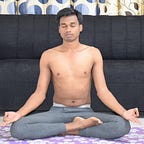Vishwamitrasana and Its Benefits!
When I initially saw this pose, I felt like it’s out of my reach. It was looking like a split and I didn’t have that flexibility in hamstring area to perform this pose. Then, I decided to practice this pose and trust me, once I got perfection in this pose, it became one of my favorite poses. It taught me to be patient, mindful and concentrate on whatever you do!
An advanced arm balance pose that stretches the hamstrings and inner thighs and tones the muscles of the arms and legs. This pose is named after the Sage Vishwamitra who was originally a Kshatriya and then became the successful rishi after gone through rigorous yogic austerities. This asana is pronounced as VISH-Vah-MEE-TRA-Sunah, Sanskrit- विस्वमित्रIसना. This is also called as Vishwamitra’s Pose.
Benefits of Vishwamitra’s Pose
- Stretches and tones the muscles of the arms, legs, and the sciatic nerves
- Strengthens the internal organs of the body and core muscles
- Improves concentration, sense of balance and body awareness
- Opens up the chest, hips and waist
- Stretches hamstrings and inner thighs
Precautions
If you have any recent medical concerns, discuss with your doctor before practicing this yoga pose. Practitioners who are suffering from lower back pain, sacroiliac injury, hamstring injury, shoulder or wrist injury should avoid this pose. This is an advanced yoga pose. If you are a beginner or have tight hamstrings, do not attempt this pose. Practitioners who are performing this asana for the first time should do it under the guidance of an expert Yoga teacher.
Steps to do a perfect Vishwamitra’s Pose
- Begin with the Downward Facing Dog (Adho Mukha Svanasana) pose. Hold this pose for a few deep breaths.
- When you feel stable, inhale and move your right foot forward and place it just outside of your right hand with your knee beside the armpit.
- Keep your left foot flat with the toes pointing outward. Lift your right hand slowly to bring it around the front of your foot. Now, bring your right shoulder underneath your knee.
- Now, you are ready to move into the full position. Ensure to keep your back of left foot firmly placed on the yoga mat. Turn the foot out if necessary so that it is pointing directly away from the left side of your body, pressing the outer edge into the mat.
- Lift your left thigh upward toward the ceiling, allowing your body to drop slightly to the left.
- Now, keep your right arm strong and steady to support the weight of the right leg. Keep your left foot and right-hand flat against the mat.
- When you feel stable, lift your left hand and wrap your hand around the top (toes) of the right foot. Inhale as you extend the right leg away from your body, straightening it out so that the bottom of your foot is facing directly in front of you.
- Continue to keep a firm hold on the foot, lifting your arm and elbow to go around and over the head. Both legs should be completely straight with an angled line connecting the left foot to the right.
- Hold this pose for a few breaths, opening up your chest toward the ceiling. Gaze towards the ceiling.
- Now, release your left hand from your foot and bend your right knee, lowering the leg. Return back to Downward Facing Dog and relax in Child’s Pose for few breaths.
- Repeat the same procedure with the other leg.
Variation
Beginners practicing for the first time can try Ardha Visvamitrasana. This half pose utilizes the same steps as the full pose, except instead of keeping the back of the left leg straight, the knee is lowered to the ground. Here, before bringing your front shoulder underneath the knee, lower the back knee to the floor. When you extend the leg, your back foot should become perpendicular to your body with the heel lifted and the ball of the foot and toes pressed into the floor.
You can also use yoga straps or yoga belts to lift your front leg in front of you. Press the right hand firmly to the mat and grab the strap with the left hand. Wrap the strap around the right foot. The strap should go around the arch of the foot. Lift the right heel and root into the ball of the foot as shown in the figure.
Tips
You must make sure to keep your stomach and bowels empty before you practice this pose. Ensure to have your meals at least four to five hours before you do the asana so that your food gets properly digested, and you can expand your body fully during the practice.
Breathe deeply in each step. If you feel like slouching your weight onto your front leg, then press firmly into your planted hand to lift your hips and pelvis. Prior to practising Vishwamitra’s Pose be sure to practice some hip and hamstring openers as the preparatory pose.
Now, don’t wait. Enjoy your yoga practice and have an awesome day! If you feel this article is helpful to you then share your experience with us by commenting below. We would be happy to hear from you!
